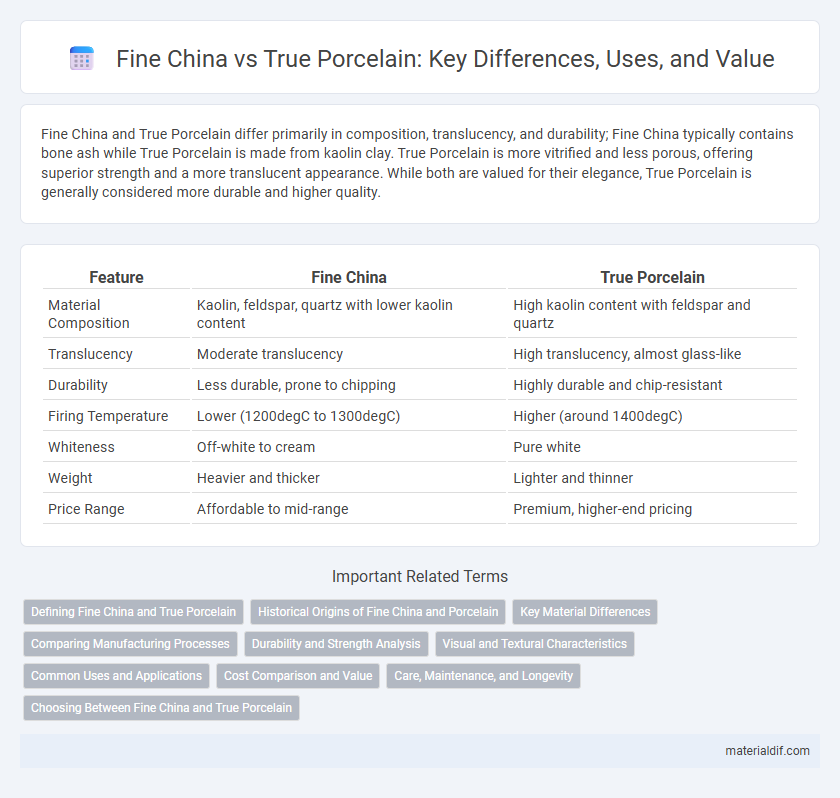Fine China and True Porcelain differ primarily in composition, translucency, and durability; Fine China typically contains bone ash while True Porcelain is made from kaolin clay. True Porcelain is more vitrified and less porous, offering superior strength and a more translucent appearance. While both are valued for their elegance, True Porcelain is generally considered more durable and higher quality.
Table of Comparison
| Feature | Fine China | True Porcelain |
|---|---|---|
| Material Composition | Kaolin, feldspar, quartz with lower kaolin content | High kaolin content with feldspar and quartz |
| Translucency | Moderate translucency | High translucency, almost glass-like |
| Durability | Less durable, prone to chipping | Highly durable and chip-resistant |
| Firing Temperature | Lower (1200degC to 1300degC) | Higher (around 1400degC) |
| Whiteness | Off-white to cream | Pure white |
| Weight | Heavier and thicker | Lighter and thinner |
| Price Range | Affordable to mid-range | Premium, higher-end pricing |
Defining Fine China and True Porcelain
Fine China refers to high-quality ceramic dinnerware made from refined clay and fired at relatively lower temperatures, resulting in a translucent yet slightly porous texture. True Porcelain is crafted from kaolin clay, fired at extremely high temperatures above 1,200degC, producing a denser, non-porous, and highly durable material with exceptional whiteness and translucency. The key distinction lies in the firing temperature and composition, with True Porcelain exhibiting superior strength and a more refined finish compared to Fine China.
Historical Origins of Fine China and Porcelain
Fine China originated in 18th-century England, where artisans developed a translucent, lightweight ceramic by adding bone ash to porcelain clay, differentiating it from traditional Chinese porcelain. True porcelain, first crafted during the Tang Dynasty in China around the 7th century, is known for its high hardness, white color, and vitrified, non-porous surface formed from kaolin and petuntse. The historical distinction reflects both geographic origin and material composition, with Fine China adapting porcelain technology to Western tastes and manufacturing techniques.
Key Material Differences
Fine China typically contains bone ash, which enhances translucency and strength, whereas True Porcelain is made from kaolin clay and feldspar, offering higher hardness and a more vitrified, non-porous finish. True Porcelain fires at higher temperatures, around 1,300degC, resulting in superior durability compared to Fine China, which fires at lower temperatures near 1,200degC. The key material differences influence mechanical properties and translucency, making True Porcelain more resistant to chipping and Fine China prized for its delicate appearance.
Comparing Manufacturing Processes
Fine china is made from a mixture of kaolin, feldspar, and quartz, fired at lower temperatures around 1,200degC, resulting in a translucent and delicate finish. True porcelain undergoes a more rigorous manufacturing process involving higher firing temperatures near 1,400degC, which vitrifies the body, making it denser, more durable, and less porous. The key difference lies in the firing temperature and composition, impacting the strength, translucency, and overall quality of the ceramic.
Durability and Strength Analysis
Fine china, often composed of bone ash, exhibits a delicate translucency but generally has lower durability compared to true porcelain, which is made from kaolin clay fired at higher temperatures. True porcelain demonstrates superior strength, resistance to chipping, and minimal porosity due to its vitrified, dense structure. This makes true porcelain more suitable for everyday use where long-lasting performance and toughness are essential.
Visual and Textural Characteristics
Fine china exhibits a translucent quality and a smooth, glossy surface with delicate patterns often featuring floral motifs, while true porcelain is marked by its pure white, highly vitrified body and a more rigid, dense texture. Fine china tends to have a slightly softer feel and may show a subtle warmth in color, whereas true porcelain is typically cooler to the touch and demonstrates superior hardness and chip resistance. The visual distinction lies in fine china's ornate decoration and translucency, contrasting with true porcelain's pristine whiteness and refined, almost glass-like finish.
Common Uses and Applications
Fine china is commonly used for elegant dinnerware and decorative pieces due to its translucency and delicate appearance, ideal for formal dining settings and special occasions. True porcelain exhibits higher durability and resistance to thermal shock, making it suitable for everyday tableware, laboratory equipment, and industrial applications. Both materials serve functional and aesthetic purposes, but true porcelain offers enhanced strength for diverse uses beyond ornamental display.
Cost Comparison and Value
Fine China generally costs less than true porcelain due to differences in materials and manufacturing processes, with Fine China often made from bone ash that lowers production expenses. True porcelain's higher price reflects its hardness, translucency, and durability, resulting from high firing temperatures and kaolin clay composition. Despite the cost, true porcelain offers superior long-term value in terms of strength and resistance to chipping compared to Fine China.
Care, Maintenance, and Longevity
Fine China requires gentle handling and avoidance of sudden temperature changes to prevent cracks, while true porcelain, fired at higher temperatures, offers greater durability and resistance to chipping. Cleaning fine china with mild detergents and soft cloths preserves its delicate glaze, whereas true porcelain's dense, vitrified surface allows for more robust cleaning methods without damage. Proper storage in padded, stable conditions extends the longevity of both types, but true porcelain generally sustains its pristine condition longer due to its superior strength and less porous nature.
Choosing Between Fine China and True Porcelain
Choosing between fine china and true porcelain depends on factors such as durability, translucency, and composition; true porcelain is fired at higher temperatures, making it denser and more chip-resistant, while fine china typically contains bone ash for added whiteness and a delicate appearance. True porcelain's vitrified, non-porous surface is ideal for frequent use and long-term durability, whereas fine china's lightweight design excels in formal dining settings with an elegant aesthetic. Understanding these material differences aids in selecting tableware that balances practicality with style preferences.
Fine China vs True Porcelain Infographic

 materialdif.com
materialdif.com